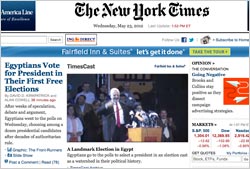Paywalls Proliferate, Most DIgital Pros Won't Pay For Them
- by Erik Sass @eriksass1, May 23, 2012
 While the figures may not be indicative of broader consumer behaviors, over half of digital media professionals who encounter online paywalls say they immediately leave the
Web site, according to a DigiCareers survey cited by eMarketer. However, there was some good news for online publishers, as a substantial number said they looked into the details of access and
pricing.
While the figures may not be indicative of broader consumer behaviors, over half of digital media professionals who encounter online paywalls say they immediately leave the
Web site, according to a DigiCareers survey cited by eMarketer. However, there was some good news for online publishers, as a substantial number said they looked into the details of access and
pricing.
Overall, 52% of digital media professionals surveyed by DigiCareers said they immediately leave a site after encountering a paywall, while 22% said they delete their cookies or try to find some other way to get the content for free. Nine percent said they ask to borrow a username and password from a friend or colleague; these figures probably overlap.
However, 42% said they actually explore the paywall pricing and at least consider a purchase decision. Furthermore, just 25% of the digital media pros said they developed a negative brand perception about a media company as a result of encountering an online paywall.
advertisement
advertisement
In terms of expectations, 90% of digital media pros said they expect to get access to at least some free content before being asked to pony up. Even more significant for publishers and advertisers, 63% said they expect no ads once they have paid for access -- although 61% said they would accept ads inside the paywall if it keeps prices down.
Less than half -- 42% -- agreed that paywalls are essential for publishers to provide high content and services -- perhaps the same cohort which was at least willing to consider paying for access).
The bad news for news publishers: digital media pros were far more willing to pay for entertainment content than for news: 47% paid for movies, 36% for digital magazines, and 35% for music, compared to just 13% for news and newspapers.
The news comes as more U.S. newspapers establish -- or consider establishing -- online paywalls for their content. On Wednesday an internal memo from McClatchy Co., which publishes The Miami Herald among other papers, revealed that company’s plans to implement paywalls at most of its newspapers using the Press+ system. The list of other major newspapers that have adopted or are in the process of adopting paywalls to date includes The Wall Street Journal, New York Times, Boston Globe, Chicago Tribune, Los Angeles Times, Washington Post, and Baltimore Sun, along with around 80 community newspapers owned by Gannett Co.



The most effective way around print paywalls is to get your news from the local radio and TV stations, many of which purloin the stories from the local newspapers. You get a story rewrite and maybe some cloying video, but basically the same story for which you would have had to pay if you read it in the paper.
Doug gets it! Paywalls will be the death of what is left of print "media".
A true "pro" will not be so cheap as to avoid all paywalls, but will be prudent enough to avoid subscribing everywhere, willy-nilly.
At some point, the Newhouses of the world will offer blanket subscriptions to all their papers at a modest premium over a single subscription.
The few remaining independents would do well to form a consortium to do likewise.
Sorry, folks, but there is no NEED to use ANY paywall-protected sites whatsoever, unless you ARE a professional and have to use THAT site.
The rest of us can get ALL the news we need without paying. I NEVER pay for site use and never will.
Even when a link I click on takes me there, I click out as soon as I get to a paywall.
One can work around pay walls by using an incognito mode ... both IE and Chrome offer those options.
The incognito link will eventually expire (i.e., one reaches the maximum number of views); however one just needs to close that particular incognito page and open a new one.